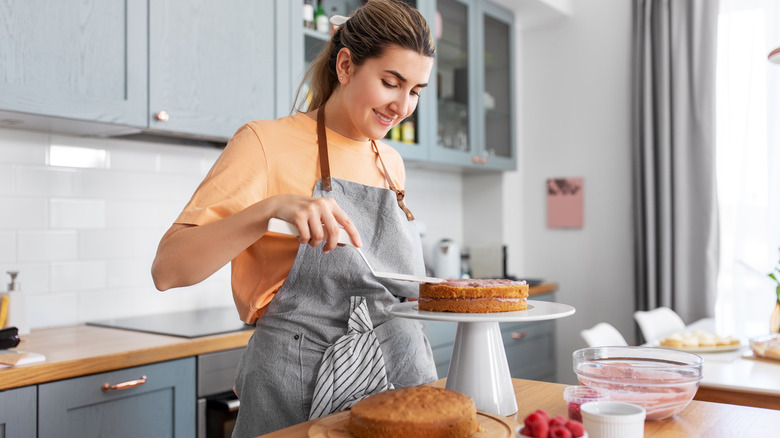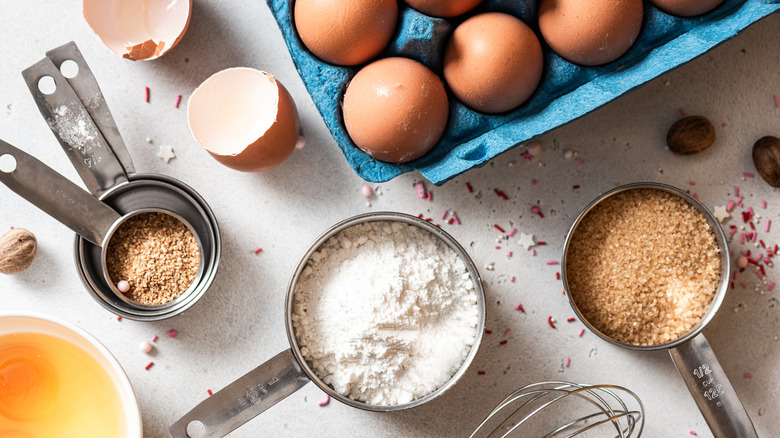The Most Ignored Cake Baking Advice Is Also The Most Obvious
There are a lot of ways to go about baking a cake, and almost as many hacks showing you ways to make it easier. However, baking a cake is not so complicated as long as you understand the mechanics behind the most common mixing methods, including blended, creaming, and foam. One of the biggest stumbling blocks when it comes to making cakes isn't anything complicated, however, it's just a matter of simply following the recipe...the whole recipe. You'd be surprised at how many people don't follow through on this simple golden rule.
When it comes to cooking, there's usually a little bit of leeway when it comes to substituting ingredients and changing techniques. A steak can be broiled instead of grilled, for example, and you can substitute walnuts instead of pine nuts in pesto. When it comes to baking, however, it's a lot more of an exact science. There has to be a certain amount of each ingredient present in order for the cake to rise properly, and each one needs to be added at specific times. Unless you're already familiar with a certain cake recipe and know what you can and can't change, cakes come out a lot better when you follow every step the way that the author intended.
Ingredients
In a professional bakery or in a restaurant kitchen, bakers will often make ingredient substitutions to use unusual or seasonal items and make interesting desserts. At home, however, most of the time when we make ingredient substitutions it's because we don't have something in the pantry. Unless you're a pastry chef, it's important to follow the directions in your cake recipe and use only what the recipe calls for. While there are definitely some substitutions that can be made, unless you've made the cake recipe before, or you know how the substitutions will behave in a specific cake recipe, stick with what works. If you swap out baking soda for baking powder, for example, your cake won't have enough acid for the leavener to make the cake rise properly. You can add a tablespoon or so of vinegar to make the baking soda work, but that may in turn alter the flavor of your cake.
If a recipe calls for a certain ingredient, it stands to reason that the author tested the recipe and decided that it was the best choice for that particular cake recipe. Unless you're a professional baker, fiddling around with substitutions is a bit like trying to play experimental jazz before you know how to play the basic notes — things can get messy pretty quickly.
Timing
Even if you use all the correct ingredients in a cake recipe, you can still go down the wrong road if you don't follow the instructions that tell you when each ingredient is added. Yes, when you make a cake from a boxed mix it's pretty safe to put all the ingredients in a bowl at the same time and stir. Cakes from scratch, however, require that the ingredients be mixed together at different times. It's extremely common, for example, for a recipe to call for mixing all the dry ingredients together, and all the wet ingredients in a separate bowl, before bringing the two together. This is done so that all of the leavener is evenly distributed throughout the batter before it comes in contact with moisture, which activates it.
The directions also tell you how long a cake needs to be baked and at what temperature. Some cakes require temperature changes or special conditions, so you can't always assume that you know what to do once the batter is mixed.
Baking a cake that doesn't turn out is one of the most disappointing things to happen in a kitchen, so don't wing it. Read your recipe once all the way through before you start baking, and then read it again backward like the pros. Once you have a feel for what ingredients and equipment you need, and what to expect in the steps, only then should you start measuring and mixing.


